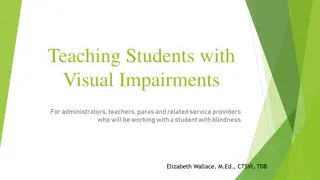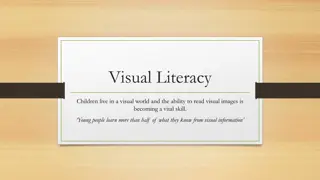Innovative Teaching Methods in Sociology: Enhancing Learning through Visual Sources
The use of visual sources and methods in sociology teaching, along with co-construction of learning and a focus on art and cinema, has proven to be engaging and empowering for both educators and students. This approach allows for deeper understanding and personal connections with the subject matter, resulting in a more impactful learning experience.
Download Presentation

Please find below an Image/Link to download the presentation.
The content on the website is provided AS IS for your information and personal use only. It may not be sold, licensed, or shared on other websites without obtaining consent from the author.If you encounter any issues during the download, it is possible that the publisher has removed the file from their server.
You are allowed to download the files provided on this website for personal or commercial use, subject to the condition that they are used lawfully. All files are the property of their respective owners.
The content on the website is provided AS IS for your information and personal use only. It may not be sold, licensed, or shared on other websites without obtaining consent from the author.
E N D
Presentation Transcript
VISUAL RESEARCH PRACTICE AND SOCIOLOGY TEACHING: SOCIOLOGY THEORY AND THE USE OF CINEMATIC FILM DR SHEILA QUAID SARAH CONNELLY
USE OF VISUAL SOURCES AND METHODS In teaching post structural theory, visual methods were utilised, allowing students to choose a visual source to critically analyse and then link it with experience, theory and practice. Optimal learning environment with holistic approach (Leavy, 1975: Mannay, 2010). It was both engaging and empowering for myself as a learning practitioner and for the learners (Freire, 1970; Hooks, 1994).
CO CONSTRUCTION OF LEARNING We currently practice co constructivist approaches. We negotiate learning and use interactive, gamified teaching methodologies. For example, asking students to set their own ground rules for discussion in sessions on difficult topics such as gender, race , sexualities and analysing these differences. Design games such as Conceptual Articulate which create a safe learning space in class and co construct curricula and assignments with them, allow students to choose visual and cultural sources for study and introduce art and music to sociological theory.
LIFELONG LOVE OF ART AND CINEMA I introduced visits to art galleries, selected TV, movies and music to the centre of studies in post structural theory. In this way in depth theory became accessible. For e.g. an illustrative quote; Being able to look at visuals and writing about it. Given sets concepts to be used making it easier to access and grasp theory.
VISUAL AND SENSORY SOURCES This echoes most student responses and led to my co- creation in new assessments where students chose sources that were meaningful to their identities, thus creating ownership of learning. Students were enabled to find ways to connect personally to these visual sources.
VISUAL SOURCES ENHANCING LEARNING Most students chose to prioritise their work with visual sources and illustrative feedback suggests a positive evident impact on their resultant student experience. The use of visual really helped the module come alive - something that even the best description and use of other sources cannot really bring to our understanding of the theory. The use of visual sources is very powerful we each took a slightly different meaning from it (Mature student).
SHARING PRACTICES . Sheila s session on the use of film and popular culture used as a catalyst for making sense of the male gaze. This session opened up my eyes to the power of film as a metaphor for students who could make the connection between the film they chose and theoretical concepts including the male gaze. The session was delivered with empathy and authenticity and from this session I was able to learn how the use of metaphor using film as a poetic enhances the sense making process of transformational learning, this is a practice I have adopted for my own praxis as I develop as a teacher. (Senior Colleague Business and Tourism)
TEACHING APPROACH This approach of teaching sociological theory, post structural and Cultural theory in the classroom go beyond standard TLA methods in Sociology. Characterised using visual sources (such as art, film, advertising and sculpture) along with co-constructivist methods and underpinned by interdisciplinary curriculum design
When I asked students to read dense amounts of post structural theory but then apply to a movie of their own choice, they displayed characteristics associated with the concept of deep learning which included, critical thinking, using theory to produce readings of the visual, deep level of interpretation and philosophical conclusions were achieved with the use of visual sources.
Student cohorts studying transgender, same sex marriage, citizenship, human rights used the visual sources to study sexual imagery and to actively interpret theory and developed learning techniques which produced deep learning. Whilst reflecting on this methodological innovation I designed a new sociology module to cover post structural theory Student cohorts studying transgender, same sex marriage, citizenship, human rights used the visual sources to study sexual imagery and to actively interpret theory and developed learning techniques which produced deep learning. Whilst reflecting on this methodological innovation I designed a new sociology module to cover post structural theory
ATTENDANCE IMPROVES Powerful connection for the students were evidenced in noticeably excellent attendance throughout. The teaching approach is conceptual based and delivers critical and analytical opportunity to move beyond threshold concepts and for students to apply them in the most immediate way and they were powerfully engaged: Overall, I think you really engaged us as students, you took the time to get to know us all individually and out of all the classes I attended during my time at university, yours was the most interesting which was evident through the consistent attendance of your students (Final year student). The use of film to help to understand theory was crucial. The visual material enabled me personally, to grasp and understand many of the topics better. certain films plot lines and important issues made it easier to recognise these elements in a broader spectrum of texts, both visual and written (final year student).
EXAMPLE PROJECT RACHEL LAWSON This project will carry out a process of decoding The Danish Girl (2015) and Of Mice and Men (Steinbeck, 1937), identifying distinctive language (Hall in Hall et al., 1980), signs and symbols (Hall in Hall, 1997a) that are signifiers (Hall in Hall, 1997a) of masculinity, femininity, power and ethnicity as examples, that have been encoded into these cultural texts (Hall in Hall et al., 1980; Hall in Hall, 1997a). For each section, relevant theory will be provided before applying it to a section of the film and/or novel to aid the decoding process and explain the range of potential messages that may have been intentionally or unintentionally encoded by the producer (Hall in Hall et al., 1980).
Illustration 2 indicates a moment when Einar realises he is transgressing his masculine identity into that of the feminine, and has crossed a symbolic boundary (Hall in Hall, 1997b) between what is acceptable in relation to masculinity into the unacceptable, effeminate performance (Butler, 1999) he has adopted (Mama, 1995; The Danish Girl, 2015)
STUDENTS' APPLICATION OF THEORY The complicit masculine (Connell, 1987; 2005) status of Einar, dressed in a suit that is regarded as effeminate, in comparison with the two men who approach him, presented as being in the hegemonic masculine (Connell, 1987; 2005) position within the context of this particular scenario (Connell, 1987; 2005; The Danish Girl, 2015). As culturally dominant within the hierarchy (Connell, 1987; 2005), the men take advantage of their status by mocking his effeminate posture and, eventually, attack him, of which is a regulatory process to indicate Einar as outside the cultural norm (Connell, 1987; 2005; Hall in Hall, 1997a; 1997b; The Danish Girl, 2015), and are assertive and aggressive in line with the Western cultural ideal that is a hegemonic masculine (Connell, 1987; 2005; Oakley, 2015) gender performance (Connell, 1987; 2005; Nixon in Hall, 1997; Butler, 1999; The Danish Girl, 2015).
From the start of SSC307and throughout it maintains itself as a student-led module, and I found that I had more freedom and independence in this module in comparison with previous modules studied, while also allowing space for regular support and guidance from the lecturer when necessary This not only acted as an ice-breaker between students and the lecturer, it also made sure that we all recognized the values and boundaries agreed by all in the session were shared by everyone on the module. These ground rules were consistently a focus during discussion throughout SSC307, and often people within a session were clear to let someone know when a ground rule was broken. It let me know that everyone was engaged and committed to participating in the module and remained so throughout the module QUOTES My ending thoughts were conflicting. I've either completely misunderstood the task or my only critique of the feminine narrative is that it lacks any. It was 17 minutes into the movie before a female character even had a line (Sean's mother). Although several female characters frequently appeared on screen, there was very little to no female influence throughout the film specific characteristics, forms of discourse and practices in everyday life - such as the denial of access to resources to genocide It is comprised of historical power relations over time, a set of ideas divided by
CRITICAL THINKING The male gaze (Mulvey, 1989) is a visual theory, hence can only be applied to visual texts (Mulvey, 1989). In the film there are key moments where Einar takes advantage of the male/masculine position of the male gaze (Mulvey, 1989; The Danish Girl, 2015), while not for sexual pleasure yet to visualise through the female body his true identity as Lili (The Danish Girl, 2015). Illustration 13 demonstrates how Einar admires Gerda as she begins to undress before he commands her to leave her nightdress it on (The Danish Girl, 2015).























